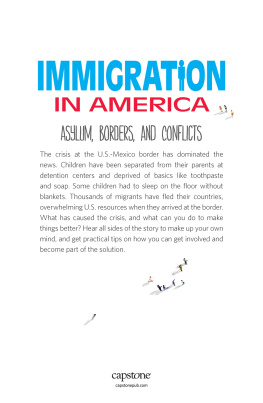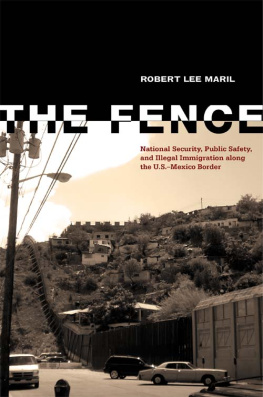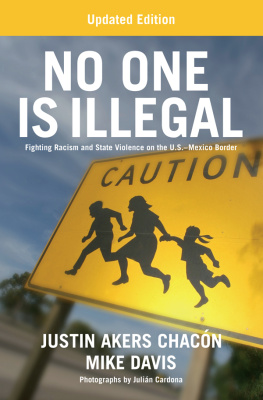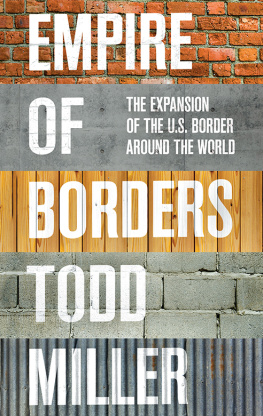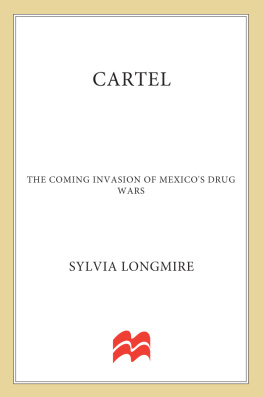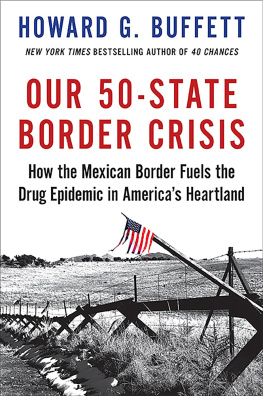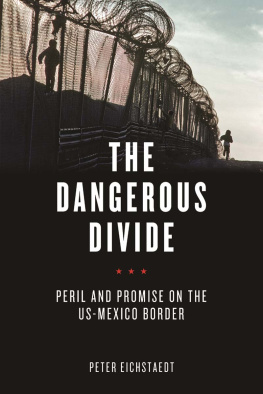Border Insecurity
Why Big Money, Fences, and Drones Arent Making Us Safer
Sylvia Longmire

The author and publisher have provided this e-book to you for your personal use only. You may not make this e-book publicly available in any way. Copyright infringement is against the law. If you believe the copy of this e-book you are reading infringes on the authors copyright, please notify the publisher at: us.macmillanusa.com/piracy.
BORDER INSECURITY
Copyright Sylvia Longmire, 2014.
All rights reserved.
For information, address St. Martins Press, 175 Fifth Avenue, New York, N.Y. 10010.
First published in 2014 by PALGRAVE MACMILLAN in the United Statesa division of St. Martins Press LLC, 175 Fifth Avenue, New York, NY 10010.
ISBN 978-1-137-27890-6
Our eBooks may be purchased in bulk for promotional, educational, or business use. Please contact the Macmillan Corporate and Premium Sales Department at 1-800-221-7945, ext. 5442, or by e-mail at .
Library of Congress Cataloging-in-Publication Data
Longmire, Sylvia.
Border insecurity : why big money, fences, and drones arent making us safer / Sylvia Longmire.
pages cm
ISBN 978-1-137-27890-6 (hardback)
1. Border securityUnited States. 2. Border securityGovernment policyUnited States. 3. United StatesEmigration and immigrationGovernment policy. 4. Immigration enforcementUnited States. 5. Illegal aliensUnited States. 6. Drug controlUnited States. 7. TerrorismPreventionUnited States. 8. National securityUnited States. I. Title.
JV6483.L66 2014
363.2850973dc23
2013035870
A catalogue record of the book is available from the British Library.
Design by Letra Libre, Inc.
First edition: April 2014
10 9 8 7 6 5 4 3 2 1
Printed in the United States of America.
For J/J/P
Contents
Introduction
There is a perception that the border is worse now than it ever has been. That is wrong. The border is better now than it ever has been.
Janet Napolitano, former DHS Secretary, March 2011
Living and conducting business in a Texas border county is tantamount to living in a war zone in which civil authorities, law enforcement agencies as well as citizens are under attack around the clock.
Texas Border Security: A Strategic Military Assessment, September 2011
O ne billion dollars is a lot of money. It can buy forty private islands or twenty-five private jets; its more than the annual gross domestic product of several small island countries. Its also the amount of tax dollars the US Department of Homeland Security (DHS) spent over the course of five years on an invisible electronic border fence that never worked.
For over a decade, US government officials, politicians, and law enforcement officers have been arguing about how best to secure our borders and how good (or bad) of a job has been done so far, spendingand wastingmore and more money along the way. During that time, the US government spent over $90 billion on border security efforts without having a truly objective way to measure successor acknowledge failure. Border security is in the eye of the beholder; ask ten different people on Capitol Hill what a secure border looks like and youll get ten different answers. Nowhere in the Library of Congress or in the history of American legislation will you find the exact parameters for a secure border, much less a clear path for how to achieve one.
There have been some half-hearted attempts by DHS officials and members of Congress to define what border security means, but none has gained any traction. In February 2011, US Border Patrol Chief Michael Fisher told Congress, Border security means public safety and the sense in the community that the border is being reasonably and effectively managed.
There is absolutely no excuse whatsoever to spend billions of dollars on border security every year without having a concrete definition of success or failure. This is what I believe border security should mean for our nation:
Border security is the act of denying our enemies the means to enter the United States to do us harm. This is achieved by identifying and prioritizing border crossers based on the level of threat they pose to our national security, and focusing our resources on either preventing their initial entry or apprehending them before they can commit criminal or violent acts on US soil.
This definition I suggest is not to say illegal immigrants should be completely ignored or allowed free access to the United States. It merely follows a line of thinking that emphasizes the word security by prioritizing threats over migration policy. In that vein, this is what a secure border should look like:
Our borders will be considered secure when US citizens can reasonably expect that our enemies cannot penetrate them without resorting to extraordinary means for which there are no existing countermeasures.
This definition takes into account the fact that we, or any other country in the world, will never be able to keep 100 percent of everyone and everything from crossing a border without detection. It also allows some leeway without making Americans think we need our own version of the Berlin Wall. But before we can appreciate the enormity of the task that is securing not just one, but two large land borders, we need to take a step backor upto understand how we arrived here.
Any human being with an Internet connection or access to a library can see what an incredible sight the Earth is from space. The oceans are a glittering sapphire blue, land masses all blend together, and the clouds are like veils, hiding and revealing mountain ranges, deserts, ice caps, and grasslands. Zooming in, we can start to see some natural features, like the Himalayan mountain range, the Sahara desert, and the Amazon River basin. Some of these natural features form part of national borders, like the Rhine River in Europe, the Rio Grande between Mexico and the United States, and the Pyrenees mountain range between France and Spain. But only from this distance of tens of thousands of vertical miles can we really understand how artificial our manmade borders are.
The concept of geographical boundaries and borders goes back to at least biblical times and ancient Greece. In the King James Bibles Book of Exodus, Moses says to the Egyptian Pharaoh, Let my people go, so that they may worship me. And if thou refuse to let them go, behold, I will smite all thy borders with frogs. The Roman Empire, which dated back to the time of the Republic in 510 bc, spanned an enormous amount of territory over the course of centuries, defined by a combination of natural frontiers and manmade boundaries. Hadrians Wall, probably the most well known of the Roman fortifications, was an impressive example of border security. Built in ad 122 and stretching seventy-three miles from the Irish Sea to the North Sea, it was the most heavily fortified defensive structure in the entire Roman Empire and cut the isle of Great Britain in two. Borders have tended to be fluid but still defined by a civilizations armies, people, and cultures.
Formal political borders are a relatively recent historical phenomenon, and even determining what was the worlds first country or first nation-state can be difficult. Along with the creation of borders came an entire host of issues, both good and bad: the ability to trade with countries outside those borders, the ability to earn income through tariffs collected at the borders, the potential need for a border security mechanism, and the inevitable creation of black markets that would seek to exploit national border weaknesses.
Our northern border with Canada, formally known as the International Boundary, stretches over 5,500 miles and is the longest land border between two countries in the world. Like so many other borders, it was created through a series of treaties and conventions, using two lines of latitude and several bodies of water as guides.
Next page

